Research Article
Community Service Learning: Fostering First Year Nursing Students' understanding of Others
1Faculty of Nursing, University of Regina, Canada
2Adjunct Professor, University of Phoenix; Grand Canyon University; University of Mary Hardin-Baylor, USA
*Corresponding author: Sherry Arvidson, Faculty of Nursing, University of Regina, Canada, E-mail: Sherry.arvidson@uregina.ca
Received: March 2, 2017 Accepted: March 20, 2017 Published: March 27, 2017
Citation: Arvidson S, Heuss R, Urban AM. Community Service Learning: Fostering First Year Nursing Students' understanding of Others. Madridge J Nurs. 2017; 2(1): 19-26. doi: 10.18689/mjn-1000104
Copyright: © 2017 The Author(s). This work is licensed under a Creative Commons Attribution 4.0 International License, which permits unrestricted use, distribution, and reproduction in any medium, provided the original work is properly cited.
Abstract
The identification of effective instructional strategies to support learning is crucial for students and beneficial for educators with the aim of instilling critical thinking and developing culturally competent learners. The lack of critical thinking among beginning practitioners has resulted in the need to ensure cultural competency and self-efficacy among learners. Providing students with learning opportunities that enhance knowledge and practical application is important in the nursing profession. Service-learning is one method of instructional pedagogy used to bridge the theory to practice gap in education. An early understanding of cultural diversity will help to prepare learners to grow in confidence and become culturally competent in their nursing career. Strategies leading to the development of critical thinking and cultural competence is important in the development of student success. Problem-based learning and reflective writing are two examples of how students learn to apply theory to practical situations and events in the community. A recent phenomenological research study explored nursing student experiences of service-learning and the transformation of knowledge. Two categories of learners evolved each with unique characteristics. After an in-depth heuristic analysis, four themes unfolded signifying the influence of service learning in nursing education. Implications for the study focus on curricular alignment, assessment of agency selection, evaluation of student learning, and opportunities for leadership.
Keywords: Service learning; Cultural competence; Nursing education; Experiential learning theory; Constructivist.
Introduction
Nurses care for diverse populations, yet, among nurses, the lack cultural competence and understanding of others have been identified in the literature [1, 27]. Service learning is one strategy that has been identified to bridge the gap between theory and practice [38]. As a result, contemporary nursing curricula has taken up Community Service-Learning (CSL), an experiential learning pedagogy [5] as a means of providing opportunities for students to be involved in their community and grow in their knowledge about others. Students learn through the application process of integrating theoretical concepts, through problem-based learning, and reflexive practice. Advancing service-learning curriculum at an early stage in educational programs may be considered as forward thinking and escalation of meaningful reflection [38].
Besides the benefits of experiencing real life situations and gaining knowledge, CSL fosters students' development of critical thinking skills [3] and social responsibility [14]. This pedagogical strategy allows students to contribute to the community by participating in learning experiences and integrating theory to practice [7]. Not only is this learning strategy important for student learning, it provides the essential knowledge and experience needed to care for diverse patient populations. Research shows that educational programs tend to favor knowledge conformation rather than knowledge construction [27]. For nurse educators, incorporating pedagogies that increase students' knowledge of culturally diverse issues is important in their learning and understanding of others. In this paper, we discuss our experience in developing and implementing a first year nursing course, which integrates the concept of cultural competence through student's CSL experience and weekly seminars.
Linking service learning to nursing education
The history of service learning evolved from the thinking of several educators. For example, John Dewey and Ernest Boyer were two of the first scholars to support the growth of experiential learning within education programs [11]. They believed the combination of knowledge and experience was key to learning. The evolution of service learning is evident in literature and dates back to nearly a century ago. From the early 1900s, educators recognized the importance of connecting service to educational pedagogy [37]. Overtime, the idea of integrating service to education grew. Several structural service-learning programs emerged in the 1960s and early 1970s as a result of student community activism [3].
By the late 1970s and early 1980s, it was believed that the concept of service learning had run its course and service learning was quickly becoming a model of the past. However, during the late 1980s, an interest in promoting civic responsibility through service in the community became renowned. Since that time, faculty, students, and administrators have integrated service learning into curriculum of various disciplines [36].
In 2009, Canada's newest nursing program, the Saskatchewan Collaborative Bachelor of Science Nursing (SCBScN) program embarked on the development of a new curriculum. After months of discussion, the philosophical tenants and the core concepts were determined. For example, it was decided that the concepts of social justice, communication, and leadership were important to shaping students' learning about culture and diversity. As such, developing and implementing a mandatory first year nursing course integrating theory and reflection through a community service learning experience was a priority for the nursing program.
Community Service Learning courses are considered most effective when key elements are drawn from experiential theory through the development of critical thinking and facilitation of reflection [38]. This combination provides students with an opportunity to make meaningful connections from community experiences with theory in the classroom. The intentional blending of theory and service-learning promotes critical reflection about their experiences. In this way, community influences promote multicultural and diversity awareness through service-learning opportunities.
Incorporating CSL into our nursing curriculum allows educators to embrace ideologies that have a strong focus on student-centered learning. Students are motivated to learn when learning experiences are stimulating and provoke critical thinking, analysis, and problem-solving skills. This model also demonstrates a shift in teaching through three essential components: the learner, instructor, and outside learning modalities.
Nurses need to feel comfortable caring for diverse populations. Improving knowledge through practice can promote cultural competency resulting in opportunities for leadership and partnerships. By improving awareness and recognition of issues occurring in society, learners gain knowledge and understanding into the concept of cultural competency [36]. For example, exposure to diverse situations in the community may assist students in developing an awareness of issues taking place among marginalized population. As well, students can demonstrate an increase in confidence and knowledge application using collaborative and critical thinking skills. Leaders in community agencies and educational members collaborate to develop projects that allow students to integrate theoretical concepts with the learning situation. Opportunities for organizing and developing project ideas provide students with experiences to participate and demonstrate a role in active leadership.
Open communication is also an important strategy to foster an opportunity for learning to take place. Utilizing the appropriate tools for learning in the classroom provides students with the essential knowledge and application of skills essential for the development of critical thinking and cultural competence. The integration of appropriate instructional strategies in service-learning may help to improve connections between theory and practice in learning [10, 16].
The role of nursing education in developing community service learning partnerships
Before students begin their experience in the community, it was important for us as nurse educators to build a partnership with the community agency and work together to achieve mutual outcomes [33]. Opportunities for students to experience social interactions will lead to the development of learning and cognition [27]. An interdisciplinary focus and collaboration with community partners will strengthen the learning process and promote an understanding of social interactions among community populations [15]. The exchange of course objectives and weekly concepts provided agency stakeholders with ideas of how to promote learning opportunities in the community. Students were encouraged to become involved in learning situations that focused on challenges and enhanced the application of knowledge to practical situations.
Students may demonstrate an increase in critical thinking and the application of knowledge in the community through academic learning and service opportunities. Through the integration of class content and community application students will have opportunities to develop knowledge through critical thinking. With the use of critical thinking, students demonstrate civic responsibility and become leaders through shared decision-making and cooperative efforts in community settings [7]. Students have an opportunity to create projects that add richness to the community and value to individuals in society. Developing projects and demonstrating creative thinking supports the experiential and constructive development in curriculum.
In service-learning, learners apply academic skills and knowledge in service to communities [8]. Learners have an opportunity to demonstrate civic responsibility through active engagement and leadership roles. An understanding of the instructional methods and student perceptions of lived experiences help leaders to monitor the effectiveness of the service-learning curriculum relevant to nursing education. Adapting to the needs of individual learners and the community may result in successful program outcomes. Evans (2015) confirmed social development, critical thinking, and cultural sensitivity as positive learning outcomes [14]. The evaluation of instructional strategies indicated if the core competencies are being met in the program [33].
In problem-based learning, learners rotate through roles of leadership at various times during the semester. The translation of theory into real life situations is indicative of qualities and characteristics of a leader in similar situations in the community [17]. Through reflective writing, students have an opportunity to discuss leadership roles that may have an influence on decision-making, project development, and enhance the life of marginalized populations [31]. Leadership roles can be learned, if adequate opportunities are available to students and partnerships. Demonstrating leadership in community settings may improve confidence levels and allow an opportunity to demonstrate cultural competency among diverse populations [4]. Both of which are essential to understanding diversity in all practice settings.
Strategies in promoting knowledge application to diverse populations
The teaching and learning strategies expand beyond linear thinking and include content that is adaptable to the changing needs of society. Two such strategies: problembased learning and reflection are essential components in service learning where students learn to integrate theory into real life situations in society [24]. The effectiveness of reflective journaling will indicate the student's level of critical development and transformation of learning [35]. Open communication and active engagement are also essential strategies to promote learning in a classroom setting, among colleagues, and with community agencies.
Problem-based learning
The integration of problem-based learning into curriculum has reached the potential to facilitate the development of problem-solving skills, higher level thinking, self-directed learning, self-confidence, effective communication skills, and transition to the work setting [2]. With the integration of problem-based scenarios, students have an opportunity to focus on becoming independent learners. Through collaboration and small group discussions, the transformation of learning results in possible solutions to existing real-life problems in society.
Reflection
The importance of reflection and application of theory to practice is essential for students to recognize the understanding of service learning among disciplines. Structured reflection promotes personal understanding and community selfefficacy [35]. Scaffolding of reflective writing provides opportunities for growth and allows students to focus on building knowledge and increasing confidence levels when caring for diverse individuals and populations. Application of constructive knowledge and diverse populations in community settings promotes an understanding of theory to practice [17]. Reflective journals serve as a tool for growth and demonstrate various levels of critical thinking.
Student Experience
Students have an opportunity to construct knowledge by adding new information to previously existing content. Alignment of curriculum with the appropriate experience is essential for learners to demonstrate motivation in learning. In small group discussions, students learn by reflecting on experiences and issues in society. Exposure and critical discussion about diverse issues promotes learning and increases confidence levels through active engagement and opportunity with situations in the community. A safe and engaging learning environment gives students the opportunity to reflect on the theory, their experience, and learn from each other [15]. Students have indicated an increased comfort level when caring for culturally diverse populations. The opportunity for reflective writing is an effective way to assist students in making connections between their service work and the course content.
Faculty Experience
Faculty members have noticed a gain in student confidence, improved communication, enhanced interpersonal skills, and an increased recognition in regards to diversity in the workplace. Awareness of diverse situations has promoted an opportunity to identify issues in the community and to formulate a plan emphasizing ways to improve the life of marginalized populations. The importance of ongoing evaluation and curriculum change is essential in maintaining a stimulating learning environment.
Evaluation of Service-learning Curriculum
Revisions and adjustments to the service-learning course have taken place since implementation of the course in the nursing curriculum. Formative and summative evaluation received by written and verbal communication has led to a collaborative decision-making evaluation from stakeholders including agency representatives, students, faculty, and institutional leaders. Course evaluations have been used throughout the four years of course delivery. Information received has been collated and shared with course leaders to determine changes and ways to improve the course over the years. To ensure students have met the course objectives, final presentations include learning that has transformed during the semester. Student presentations include the course concepts and examples of leadership opportunities. Providing student with an opportunity to reflect on meaningful situations led to the awareness and recognition of diverse situations among community populations.
Outcomes of Service-Learning
An extensive literature search on the outcomes of service-learning, reveal researchers strongly emphasize a positive influence on learning [6, 23]. While qualitative data on service-learning are available, quantitative data are limited. The literature supports positive outcomes outweigh the negative outcomes in service-learning [1, 8, 14, 36]. Phenomenology is used as a common research design in nursing education [30, 34]. To clearly see the outcomes of service-learning in nursing education, faculty should implement a rigorous method for evaluating the efficacy of service-learning on specific course outcomes. Disseminating such information through publication of the results should be recommended to contribute to the body of evidence about service-learning in nursing education [28].
Positive Learning Outcomes
The benefits of service-learning in nursing curriculum strongly suggest a positive learning environment. Condon, Grimsley, Knaack, Pitz, and Stehr (2015) posited one foundational benefit of service-learning is developing skills in learning to address real-life experiences that focus on meeting a community need [7,9,12]. Informative data in the literature central to feedback and evaluation of service-learning included meaningful learning experiences, community building, developing academic relations, and service benefits among partners [32]. Additional benefits to students include increased knowledge, confidence, time management, social responsibility, communication, teamwork, and networking skills [20]. Benefits to academics, service partners, and community partners were central components to the theme of building relations.
Treff and Earnest referred to academic growth and development as the outcome for integrating service-learning into educational programs [38]. Positive outcomes were associated with service-learning and included the development of leadership skills [22, 11] identified making connections with knowledge and skills; and understanding culture, values, and ethics as important factors in service-learning. Strategies that assist learners to develop knowledge and build awareness are inclusive to reflective and critical thinking exercises [19].
Evans (2015) confirmed service-learning benefits communities, universities, and students. Service-learning courses are increasingly popular in college classrooms across the country [25]. Kearney (2013) related to the benefits of integrating a community service-learning course to enhance the development of life skills. Findings from a qualitative research study included themes of cultural sensitivity, teamwork, and communication skills [18]. The importance of including communication, critical thinking, research, collaborative activities, and cultural diversity in course outcomes is essential in the construction of knowledge [36].
Negative Learning Outcomes
Despite the abundance of positive outcomes, few negative outcomes exist [21]. Questions remain about the service approach in learning and the availability of agencies to meet student demands for relevant experiences [21]. The importance of linking curriculum with social justice as a framework to enhance service-learning in the community is considered essential for the development of civic engagement. If the curriculum is not properly aligned with course concepts, service-learning has the potential to reinforce negative stereotypes regarding power inequalities between students and community members in need [18]. Smit and Tremethick reinforced the importance of aligning course content to experiences in the community [36]. Without the integration of social justice, students struggle toward the true meaning of service-learning.
Critically examining components in service-learning is imperative so maximum benefits can be obtained among the learner, institution, and community agency. Limited qualitative research relevant to service-learning in health care is available which supports the need for exploring the topic in nursing education. Strategies to improve learning and cultural awareness, is essential in the nursing profession [2]. Gaining an understanding of how students develop and apply knowledge to experiences in the community may provide a framework to improving curriculum [36]. Diaz, Clarke, and Gatua (2015) identified service-learning as an opportunity to foster cultural competence among practitioners and emphasized the importance of recognizing strategies to implement in academics such as nursing education [13].
Methodology and Design
The research approach used was heuristic phenomenology described by [26] as a journey that begins with a personal question or challenge and has a significant influence on social or universal aspects. The process began with a personal quest to understand how service learning can be used to facilitate learning. The end result was astonishing and reached far beyond endless opportunities to enhance nursing education. As an educator, this research study provided a starting point for new developments and innovations in nursing education. The data collected is vital and supports reason for improving the quality of learning among students entering the field of nursing.
The technique used in the study was the presentation of narratives in the form of journal entries. The journal entries consisted of abundant and stand alone information that could be told as a story. A Creative Synthesis was developed from the participants' journal entries. First person reports of actual experiences increased the validity of the research study. Similar to the journal responses, the interview sessions were rich and reflected in-depth meaningful learning that transformed from the classroom to the community. Audio recorded and professionally transcribed interviews captured valuable data from 13 participants. The information obtained was descriptive of new knowledge and skill that developed throughout a semester of service learning. Semi-structured open-ended questions were used to facilitate participant engagement and resulted in intense emotion and reflective sharing. The final step of the research study led to the synthesis of true meaning and revealed the essence of the phenomenon.
Using the heuristic approach to understand how students become avid learners provides educators with a framework that can be integrated into various academic programs [9]. Understanding how students develop processes to critically think and become culturally competent in practice is important for educators and professions. In nursing education, heuristic inquiry offers nurses the potential to explore questions that emerge from within. Developing a framework based on the themes can provide researchers with the tools needed to become successful learners. As with any research, challenges do exist and the need to make revisions and become involved in additional projects is ongoing. Steps and evidence taken into consideration for the heuristic inquiry captured rich and meaningful data (See Table 1)
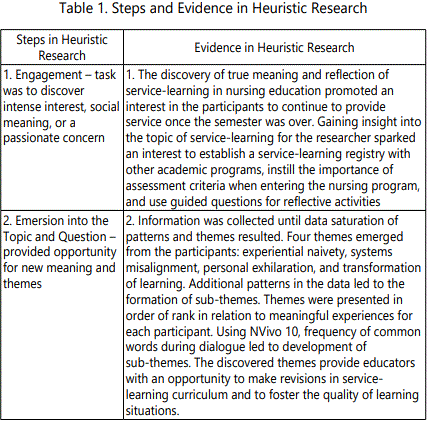

An emphasis on the internal frame of reference, selfsearching, intuition, and indwelling steps of heuristic inquiry made experiencing the connectedness and relationship development with the participants possible. The data collected produced rich and meaningful results. Through a heuristic lens themes illuminated and were recognized as new discoveries in research. The underlying themes may be a consideration for developing frameworks and models in service learning. The themes represented the development and application of knowledge to foster learning. The Creative Synthesis included the knowledge and themes gained from the data collected during the illuminating and explicating steps of heuristic inquiry. The outcomes signified a creative discovery of intuition and tacit understanding.
The research questions represented the participants' essences of experiences and focused on knowledge application by focusing on the concept of leadership developed during the service learning experience. An in-depth reflection of how leadership contributes toward the nursing profession provided participants with an opportunity to make connections between theory and experience. The data were specific to each participant's lived experience of service learning and individual perceptions of learning (See Table 2)
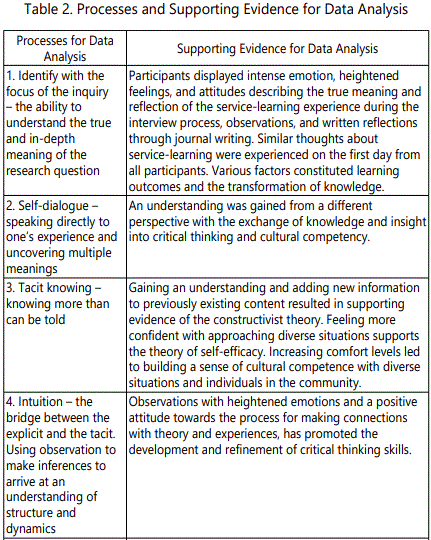
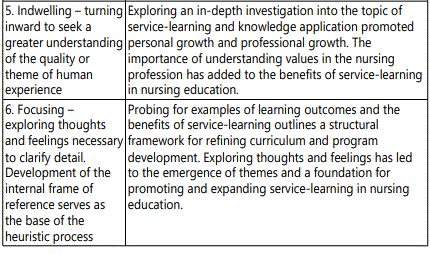
Results
An exploration into the experiences of 13 first year nursing students revealed two categories of learners each with characteristics representing true meaning of service-learning curriculum in nursing education. Participants were identified as those having prior training or education and those without any prior workplace exposure. Participants with prior experience or education did not show initiative throughout the semester of learning and as a result had a less than satisfying experience (See Figure 1). Participants without prior training or experience were motivated to learn and demonstrated a positive experience (See Figure 2). Data saturation supports four following themes: experiential naivety, systems misalignment, personal exhilaration, and transformation of learning.
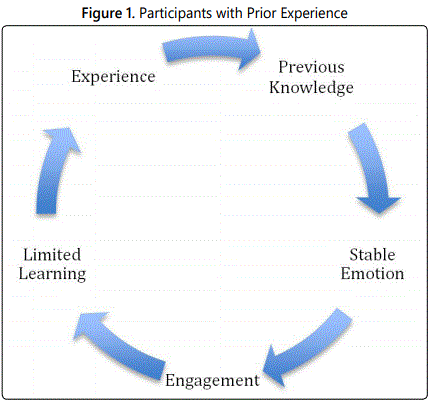
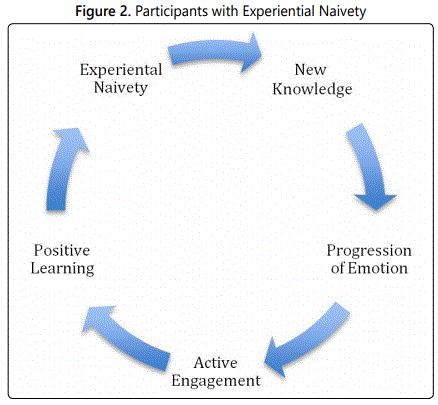
Conceptual frameworks of experiential learning, constructivism, and self-efficacy theories support the findings in the research study. Instructional methods using problem-based learning and reflection were identified as beneficial to the learning process and are dependent on the needs of the learner. As educators, assessment and evaluation are deemed essential elements to ensure the transformation of learning takes place.
Discussion
Service-learning was described as an educational learning practice which included the meaningful application of concepts to actual situations and individuals in need. An understanding that service-learning involved the application of academic learning and experience was expressed. Service-learning was described as the process of being able to feel confident and comfortable with diverse individuals and populations in the community at the time of need. The period of illumination served as an opportunity to develop new dimensions of knowledge. Service opportunities when aligned with learning concepts in the curriculum promote critical thinking, build working relationships, develop culturally competent learners, and create community partnerships.
A period of illumination described as an awakening moment included the realization that service-learning opportunities need to closely align with conceptual frameworks for students to achieve the maximum benefit of learning. For service learning experiences to be successful, program coordinators, agency workers, and educators need to work closely together to ensure the course objectives can be achieved through classroom instruction and agency experience. Open and active communication should play a role in achieving the success in the program and building partnerships.
A second illumination from the data came through by recognizing differences existed between participants with prior experience and those having no prior health related training. The cycle of learning for the novice learner resulted in a stronger display of emotion and active engagement making the end result of learning meaningful and rich. The cycle of learning for the experienced participant resulted in similar components but at a lesser intensity of experience with emotion, engagement, and learning outcomes. The theme of experiential naivety promoted sub-themes reflecting a cycle of learning for participants without any prior related training or educational career.
Conclusions and Implications
The findings conclude the integration of service-learning into nursing education has increased comfort levels, increased confidence, and enhanced the ability to make connections by applying theory to experiences in the community. Gaining an understanding of the experiences and essences of service learning has personally led to the potential of developing a system for agency registry at the local university. Reason to make improvements with the service-learning course has enticed enrichment of the curriculum in nursing education. Offering students a choice for agency placements based upon personal intentions and academic objectives will guide students to become avid learners and promote the development of leadership roles at an early stage in the nursing program [29,30,34].
The ability to make connections between classroom theory and experiences in the community increased the process of negotiating a time schedule to fulfill hours and provide a complex abstract of agency duties.
Building relationships among faculty, students, and community members was seen as a positive attribute of service learning in nursing education. The findings serve as evidence, which can be used toward strengthening and enhancing the curriculum in service-learning. Awareness of student perceptions and lived experiences made it possible to improve learning opportunities with various community stakeholders and faculty members. Implications from the study can be used by leaders in the community and with members of the teaching institution in various capacities. Developing community partnerships provides avenues for building capacity in innovative ways for nursing education.
Service-learning is an ideal strategy to bridge the gap between theory and practice. As a result, learning outcomes will support the transformation of critical thinking at the undergraduate level of nursing education. The use of teaching and learning strategies of problem-based learning and reflection will contribute toward the effectiveness of student perceptions and constructive knowledge in the community. Integrating service-learning into nursing curricula could result in an increase in student self-efficacy and enhanced development of critical thinking. Feelings of comfort with communication, professional interaction, and making connections with theory and practice may be seen as a positive learning experience. Emphasizing the need for service-learning at an early stage in the nursing program may be viewed as a critical strategy in fostering cultural competency among diverse populations. The need to be creative and facilitate learning opportunities for students is important for all nursing programs. Not only will this prepare students for their career it also serves to provide them with the necessary skills in understanding others.
Conflicts of Interest: The Authors reports that their is no conflict of interest.
References